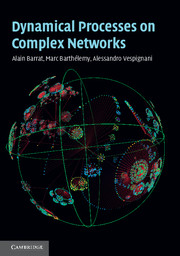Book contents
- Frontmatter
- Contents
- Preface
- Acknowledgements
- List of abbreviations
- 1 Preliminaries: networks and graphs
- 2 Networks and complexity
- 3 Network models
- 4 Introduction to dynamical processes: theory and simulation
- 5 Phase transitions on complex networks
- 6 Resilience and robustness of networks
- 7 Synchronization phenomena in networks
- 8 Walking and searching on networks
- 9 Epidemic spreading in population networks
- 10 Social networks and collective behavior
- 11 Traffic on complex networks
- 12 Networks in biology: from the cell to ecosystems
- 13 Postface: critically examining complex networks science
- Appendix 1 Random graphs
- Appendix 2 Generating functions formalism
- Appendix 3 Percolation in directed networks
- Appendix 4 Laplacian matrix of a graph
- Appendix 5 Return probability and spectral density
- References
- Index
4 - Introduction to dynamical processes: theory and simulation
Published online by Cambridge University Press: 05 September 2012
- Frontmatter
- Contents
- Preface
- Acknowledgements
- List of abbreviations
- 1 Preliminaries: networks and graphs
- 2 Networks and complexity
- 3 Network models
- 4 Introduction to dynamical processes: theory and simulation
- 5 Phase transitions on complex networks
- 6 Resilience and robustness of networks
- 7 Synchronization phenomena in networks
- 8 Walking and searching on networks
- 9 Epidemic spreading in population networks
- 10 Social networks and collective behavior
- 11 Traffic on complex networks
- 12 Networks in biology: from the cell to ecosystems
- 13 Postface: critically examining complex networks science
- Appendix 1 Random graphs
- Appendix 2 Generating functions formalism
- Appendix 3 Percolation in directed networks
- Appendix 4 Laplacian matrix of a graph
- Appendix 5 Return probability and spectral density
- References
- Index
Summary
The present chapter is intended to provide a short introduction to the theory and modeling of equilibrium and non-equilibrium processes on networks and to define the basic modeling approaches and techniques used in the theory of dynamical processes. In particular, we define the master equation formalism and distinguish between equilibrium and non-equilibrium phenomena. Unfortunately, while the master equation allows for important conceptual distinction and categorization, its complete solution is hardly achievable even for very simple dynamical processes. For this reason we introduce the reader to techniques such as mean-field and continuous deterministic approximations, which usually represent viable approaches to understand basic features of the process under study. We also discuss Monte Carlo and agent-based modeling approaches that are generally implemented in large-scale numerical simulation methods.
These different theoretical methods help to define a general framework to demonstrate how the microscopic interactions between the elements of the system lead to cooperative phenomena and emergent properties of the dynamical processes. This strategy, going from microscopic interaction to emergent collective phenomena, has its roots in statistical physics methodology and population dynamics, and is currently viewed as a general paradigm to bridge the gap between the local and the large-scale properties of complex systems. It is important to stress, however, that the following material is a greatly abbreviated presentation of a huge field of research and by necessity just scratches the surface of the statistical theory of dynamical processes.
Information
- Type
- Chapter
- Information
- Dynamical Processes on Complex Networks , pp. 77 - 91Publisher: Cambridge University PressPrint publication year: 2008
Accessibility standard: Unknown
Why this information is here
This section outlines the accessibility features of this content - including support for screen readers, full keyboard navigation and high-contrast display options. This may not be relevant for you.Accessibility Information
- 2
- Cited by
